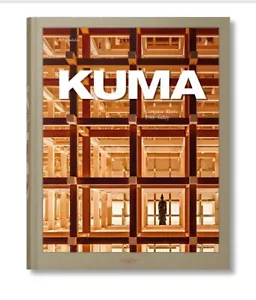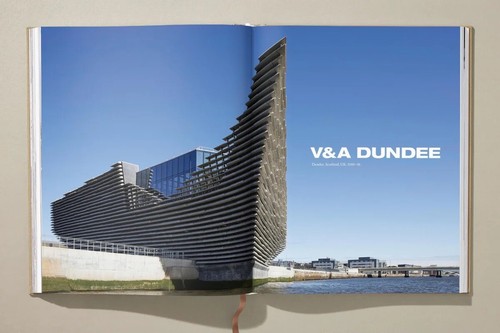Imagen 1 de 17

















Galería
Imagen 1 de 17

















Kuma. Complete Works 1988 - Today. 2021 Ed by Philip Jodidio (English) HUGE Book
USD180,00
Aproximadamente157,94 EUR
Estado:
Nuevo
Libro nuevo, sin usar y sin leer, que está en perfecto estado; incluye todas las páginas sin defectos. Consulta el anuncio del vendedor para obtener más información.
2 disponibles
Oops! Looks like we're having trouble connecting to our server.
Refresh your browser window to try again.
Envío:
USD12,88 (aprox. 11,30 EUR) USPS Media MailTM.
Ubicado en: Wichita, Kansas, Estados Unidos
Entrega:
Entrega prevista entre el mié. 11 jun. y el mar. 17 jun. a 94104
Devoluciones:
No se aceptan devoluciones.
Pagos:
Compra con confianza
El vendedor asume toda la responsabilidad de este anuncio.
N.º de artículo de eBay:226599133839
Última actualización el 30 abr 2025 01:39:39 H.EspVer todas las actualizacionesVer todas las actualizaciones
Características del artículo
- Estado
- Type
- Does not apply
- ISBN-13
- 9783836575126
- ISBN
- 9783836575126
Acerca de este producto
Product Identifiers
Publisher
Taschen
ISBN-10
3836575124
ISBN-13
9783836575126
eBay Product ID (ePID)
21038632128
Product Key Features
Book Title
Kuma. Complete Works 1988-Today. 2021 Edition
Number of Pages
460 Pages
Language
English
Publication Year
2021
Topic
Individual Architects & Firms / Monographs, History / Contemporary (1945-), General
Illustrator
Yes, Kuma, Kengo.
Genre
Architecture
Format
Hardcover
Dimensions
Item Height
2.3 in
Item Weight
192.4 Oz
Item Length
18.4 in
Item Width
13.6 in
Additional Product Features
Intended Audience
Trade
LCCN
2022-389402
Reviews
A richly illustrated overview of Kuma's oeuvre that delves into his complete archive of built landmarks across the globe., For the past 30 years, I have been driven to create architecture by the desire to recover materials, and to reconnect people and physical things. It turned out to be the most enjoyable experience imaginable. This is because the world itself is material., This immense architectural tome establishes once and for all that sustainability and style need not be set at odds., Through descriptions, elevation drawings, sketches, and photographs, the architect's signature texture seems to jump off the page.
Dewey Edition
23
Dewey Decimal
720.92
Edition Description
Multilanguage edition
Synopsis
After Tadao Ando, Toyo Ito, and Fumihiko Maki, Kengo Kuma has breathed renewed vigor and lightness into Japanese architecture . Departing from the modernist skyscraper of the 20th century, Kuma traveled through his native Japan to develop a truly sustainable approach, translating local craftsmanship and resources into site-specific, timely buildings. Informed by tradition, and with both feet firmly planted in the present, this "materialist" heralds a new tactile architecture marked by its engaging surfaces , innovative structures , and fluid forms , reconnecting people with the physicality of a house . Kuma's objective, above all else, is "just to respect the culture and environment of the place where I am working." To this end, Kuma shaped the China Academy of Art's Folk Art Museum partially from discarded roof tiles; created a Chapel out of birch and moss in Nagano; and worked with local craftsmen to sculpt the V&A Dundee into a twisted, layered reflection of the Scottish coastal cliffs. With an extraordinary sensitivity for space, light, and texture, Kuma reveals unexpected qualities in materials, finding the weightlessness of stone in Chokkura Plaza and the softness of aluminum in the thatched roof of the Yangcheng Lake Tourist Transportation Center . More recently, the architect brought his philosophy to the Japan National Stadium built for the Olympic Games, originally planned for 2020. Kuma has said the stadium could be "the catalyst that will transform Tokyo back from a concrete city. I want it to set an example that will help alter the direction of Japanese architectural design." In this XXL-sized monograph with some 500 illustrations spanning photographs , sketches , and plans , Kuma guides us through his entire career to date, detailing milestone projects as well as ongoing works ., After Tadao Ando, Toyo Ito, and Fumihiko Maki, Kengo Kuma has breathed renewed vigor and lightness into Japanese architecture. Departing from the modernist skyscraper of the 20th century, Kuma traveled through his native Japan to develop a truly sustainable approach, translating local craftsmanship and resources into site-specific timely buildings. Informed by tradition and with both feet firmly planted in the present, the "materialist" heralds a new tactile architecture marked by its engaging surfaces, innovative structures, and fluid forms, reconnecting people with the physicality of a house. Kuma's objective, above all else, is "just to respect the culture and environment of the place where I am working." To this end, Kuma shaped the China Academy of Art from discarded roof tiles, which rise and fall along with the natural terrain; created a chapel out of birch and moss in Nagano, Japan; and more recently worked with local craftsmen to sculpt the V&A Dundee into a twisted, layered reflection of the Scottish coastal cliffs. With an extraordinary sensitivity for space, light, and texture, Kuma reveals unexpected qualities in matter, finding the weightlessness of stone in Chokkura Plaza and the softness of aluminum in the thatched roof of the Yangcheng Lake Tourist Transportation Center. Now, the architect is bringing his philosophy of architecture in harmony with its environment to a project of unprecedented scale and importance: Japan's National Stadium for the 2020 Summer Olympic Games, now near completion. Kuma has said the stadium could be "the catalyst that will transform Tokyo back from a concrete city. I want it to set an example that will help alter the direction of Japanese architectural design." In this XXL-sized monograph jam-packed with some 700 illustrations spanning photographs, sketches, and plans, Kuma guides us through his entire career to date, detailing milestone projects as well as ongoing works.Also available in a Collector's Edition limited to 200 copies, each signed by Kengo Kuma, The future of architecture has never been so closely tied to the future of the planet--and in our search for solutions, we'd do well to look to Kengo Kuma. From bamboo walls to the Tokyo 2020 Olympic stadium, the Japanese architect is one of the world's leading pioneers in developing a truly sustainable approach to building, translating local..., From his Great (Bamboo) Wall house to the Japan National Stadium for the 2020 Summer Olympics, Japanese architect Kengo Kuma pioneered sustainability in architecture, turning local craftsmanship into a new, tactile approach. Discover his oeuvre in this extensive monograph., After Tadao Ando, Toyo Ito, and Fumihiko Maki, Kengo Kuma has breathed renewed vigor and lightness into Japanese architecture. Departing from the modernist skyscraper of the 20th century, Kuma traveled through his native Japan to develop a truly sustainable approach, translating local craftsmanship and resources into site-specific, timely buildings. Informed by tradition, and with both feet firmly planted in the present, this "materialist" heralds a new tactile architecture marked by its engaging surfaces, innovative structures, and fluid forms, reconnecting people with the physicality of a house. Kuma's objective, above all else, is "just to respect the culture and environment of the place where I am working." To this end, Kuma shaped the China Academy of Art's Folk Art Museum partially from discarded roof tiles; created a Chapel out of birch and moss in Nagano; and worked with local craftsmen to sculpt the V&A Dundee into a twisted, layered reflection of the Scottish coastal cliffs. With an extraordinary sensitivity for space, light, and texture, Kuma reveals unexpected qualities in materials, finding the weightlessness of stone in Chokkura Plaza and the softness of aluminum in the thatched roof of the Yangcheng Lake Tourist Transportation Center. More recently, the architect brought his philosophy to the Japan National Stadium built for the Olympic Games, originally planned for 2020. Kuma has said the stadium could be "the catalyst that will transform Tokyo back from a concrete city. I want it to set an example that will help alter the direction of Japanese architectural design." In this XXL-sized monograph with some 500 illustrations spanning photographs, sketches, and plans, Kuma guides us through his entire career to date, detailing milestone projects as well as ongoing works.
LC Classification Number
NA1559
Descripción del artículo del vendedor
Acerca de este vendedor
Classic Curation Co
100% de votos positivos•194 artículos vendidos
Registrado como vendedor particularPor tanto, no se aplican los derechos de los consumidores derivados de las leyes de protección de los consumidores de la UE. La Garantía al cliente de eBay sigue aplicando a la mayoría de compras. Más informaciónMás información
Votos de vendedor (64)
- 9***d (150)- Votos emitidos por el comprador.Últimos 6 mesesCompra verificadaMy experience with “Classic Curation Co” was great and I’d recommend checking out this shop for yourself. I purchased 3 books and they came exactly as described plus they was reasonably priced. PIus, I received a refund on my shipping cost since I ordered more than one item at the same time. Very much appreciated!!! I also received my order at least 2 days earlier than expected and packaged with care. Thanks again!l
- a***2 (197)- Votos emitidos por el comprador.Últimos 6 mesesCompra verificadaExcellent communication. Very well packaged!!! Item exactly as described. Fast secure shipping!!! Will purchase from this seller in the future.
- s***n (1043)- Votos emitidos por el comprador.Mes pasadoCompra verificadaThe photos don’t do it justice! I’m beyond happy with my purchase. Better than described, lovingly packaged, fantastic communication from a very lovely seller ⭐️⭐️⭐️⭐️⭐️

